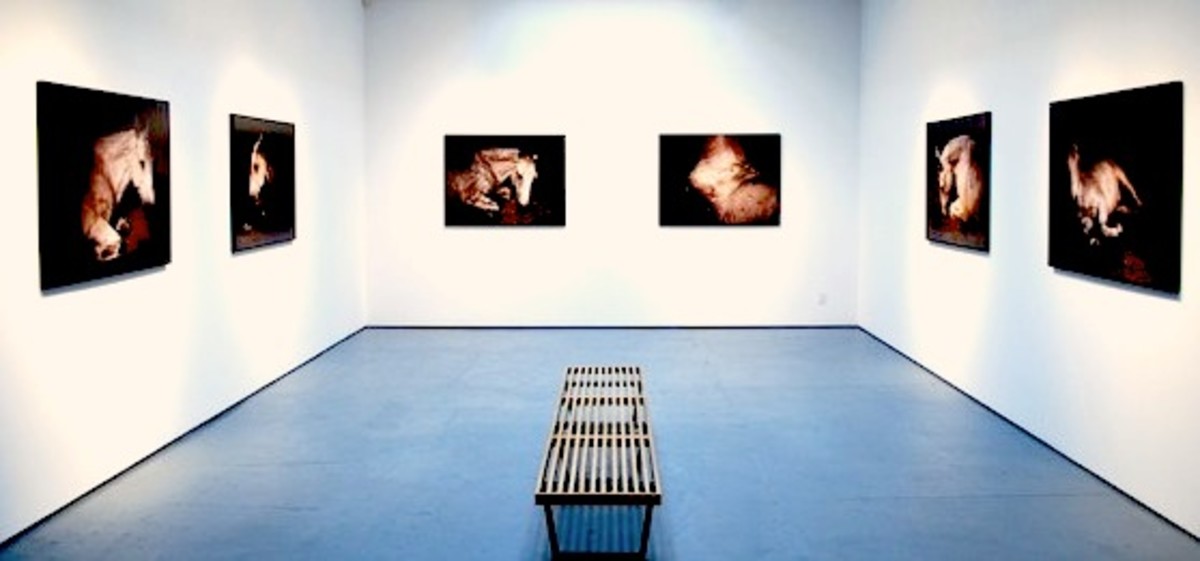There’s an old superstition that when a whole herd of dairy cows is lying down in the field, rain is on its way.
So what does a whole barn of horses laying down mean? It means that night has come, and the horses need their sleep.
Just ask photographer Charlotte Dumas.
Charlotte is the eye behind the lens; she has created one of the most unusual–and extraordinary–horse art exhibits to come our way in a while. This Dutch photographer is intrigued with the recumbent horse, and the vulnerable intimacy she achieved and documented among ?a group of extraordinary horses will make every horseperson’s pulse quicken.
Possibly because it is a vulnerable intimacy that many of us know well.
Not only did Charlotte photograph horses lying down–anyone could do that with a long lens–she spent two years around the horses at night. After a while, they allowed her to enter their stalls without rising in the well-known flight response exhibited by horses who are startled or nervous. Eventually, they didn’t even blink.
And these weren’t just any horses. They were some of the most symbolically important horses in the United States: the Lipizzaner hitchmates of the Old Guard caisson unit. Technically the property of the Department of Defense, these horses pull the gun carriage that transports military caskets during funerals at the Arlington National Cemetery outside Washington.
The series, called Anima, is drawn from Charlotte’s first one-person museum exhibition in the United States, and was originally commissioned by and exhibited at the Corcoran Gallery of Art in Washington, DC. A selection of the horse portraits is now on view at Manhattan’s Saul Gallery.
For me, what it outstanding about Charlotte Dumas is that she captures horses at their most vulnerable moments. One of my favorite of her images shows a Dutch police horse with his knees buckled in that split second when a horse lowers himself for a roll.
In the New York exhibit, gallery visitors watch a video of the caisson horses as they drift in and out of sleep.

Many people recognize Charlotte Dumas as the photographer of the 2011 “Retrieved” series in which she located most of the surviving dogs that did urban search and rescue work after 9/11 in New York. Her sleepy horses have the same trust and innate spirit shown in those remarkable dog portraits.
When I asked Charlotte about approaching these sleepy horses, she said, “They are (either) relaxed or not and if they are, they’ll lay down and let me come close. This takes time.
“As I spent time with them at night, I felt this was one of the most intimate and private moments to witness: the gap between wakefulness and slumber, a space for dreaming and reverie.”
Charlotte wanted horse owners to know, “The distance on my photographs equals the real distance I had towards them when I took the photograph.”

While I was working on this story, the Department of Defense released news that the horses in Charlotte’s images had been involved in an odd and dangerous mishap while working at Arlington National Cemetery. The horseshoe of a horse named Babe caught in a grate; of course, the six-horse hitch was moving forward with the momentum of six pulling horses.
The grate was wrenched out of the pavement, stuck to the horse’s shoe.
The horse harnessed behind Babe, Tilman, fell into the open hole that was left. To make matters worse–and more dangerous–this happened on an incline, and when the horses stopped, the caisson rolled back.
An alert soldier, Army Spc. Jacob Eberly, ran back to the wheels of the massive gun carriage and put his shoulder to work: he forced the wheel to roll forward, and Tilman was able to pull himself out of the hole with the slackened harness.
“The farther the caisson would go back, the farther Tilman would go down into the hole,” Eberly said in a report. “I ran to the back where the wheels were and grabbed the spokes and began pushing the wagon forward. I was just trying to help my horse as much as possible.”
Tilman is now recovering, without major injury, according to the Department of Defense.
Many of us are captivated by the peace and warmth of horse barns at night. We know very well the sounds and smells of a darkened stable.
Walking from one image to another in the New York exhibit is literally like walking through a barn at night. The clever exhibition design has mounted the images in parallel, linear rows, as if you are strolling from one stall to the next and peek in at each horse in turn.
It’s like a midnight blanket check: does everyone have water? Is Roosevelt’s door double-latched? Tilman’s not chewing his leg bandage, is he?
I know a place in Manhattan where you can perform an intimate night-check on a barnful of horses, in the broad daylight. And they’ll let you come up close, thanks to the patience and vision of Charlotte Dumas.
The Julie Saul Gallery’s Charlotte Dumas “Anima” exhibit closes in New York on March 9. If you can’t get there to see the images, Charlotte creates books for each of her exhibits. Order the book of the horse portraits from Anima by emailing Charlotte; the cost is $35.
Special thanks to Stacy Nedrow-Wigmore of Practical Horseman magazine for alerting me about what happened to Babe and Tilman.








